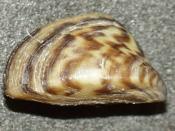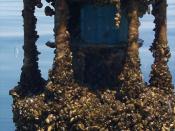Page 1
SCIE 131
Assignment 4-1
The Zebra Mussel (Dreissena polymorpha) is a mollusk native to an area in the Ukraine and Russia near the Black Sea and the Caspian Sea. In the 1700's and 1800's canals were built around the seas and into Europe to make shipping easier. Theses canals also allowed the Zebra Mussel to expand into new areas. It appears that in 1985 or 1986 the Zebra Mussel had been introduced to the Great Lakes region and was discovered in Lake Erie in 1988. It is believed the Zebra mussels were carried in the ballast water of transoceanic ships entering the Great lakes. By 1996 Zebra Mussels had been found in all of the Great Lakes (Zebra Mussels in North America).
The Great Lakes provides an environment that provides the elements needed for the Zebra Mussel to thrive. Zebra Mussels are filter feeders and feed primarily on planktonic algae and detritus, which was abundant in the Great Lakes.
The lakes water temperature ranges from 32 degrees to 86 degrees Fahrenheit and is fresh water. The Zebra Mussels range of tolerance is from a preferred 54 degrees to 68 degrees Fahrenheit. It has been discovered they have the ability to easily adapt to higher water temperatures. The Zebra Mussel will begin spawning when water temperature reach 54 degrees and continues until the temperature drops below 54 degrees. This means the spawning season could be as long as five months (Zebra Mussels in North America). All of these factors fit into the Zebra Mussels range of tolerance thus maximizing its biotic potential.
Page 2
Another factor that has lead to the rapid increase in the Zebra mussel population is the low number of natural predators. Their high reproduction rate makes it impossible for the predators to...


